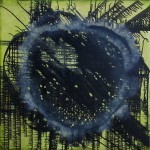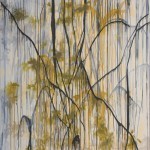
After years of landscape painting I began to realize that scenery was not so interesting to me as the fundamental biology behind the scene and our pervasive role in the system represented. I am fascinated by human progress, by the effects of human advancement and by the complicated interrelationships of those effects. Moore’s law, which describes an exponential growth pattern in the complexity of semiconductor circuits, was extended by the well known futurist Ray Kurzweil to describe exponential growth of diverse forms of technological progress. Whenever a technology approaches some kind of a barrier, he said, a new technology will be invented to allow us to cross that barrier. He predicted that such paradigm shifts have and will continue to become increasingly common, leading to “technological change so rapid and profound it represents a rupture in the fabric of human history.” It is widely agreed that technological progress is now the primary factor driving the development of human civilization. This continual acceleration occurs because new technological systems continually use fewer and fewer resources (like matter, energy, space and time) to accomplish physical or computational change. As a result, the limits to exponential growth that are seen in a system of fixed complexity are theoretically avoided, unlike the natural limits of, say, bacteria growing in a pond, which can multiply only until local resources are used up. The past fifty years have brought about an unprecedented increase in the welfare of humankind propelled by technology. The flip side to this progress, however, is that with accelerating growth comes accelerating planetary dissolution and degradation. While it is true that economic growth and technological growth are tightly linked, there is a conflict between growth and environmental protection that technology can lessen but not reconcile. Human health is still ultimately dependent upon the integrity of ecosystems.
The overall picture of these correlations becomes so complicated and entangled that I find my mind boggled. I am inspired to paint the world as a glowing font of potential, superimposed upon systemic struggle and dissonance, graced by the adaptive and mutational perseverance of biology. Moral judgments of right or wrong are not as interesting to me as observing the actions and reactions within the system. That is not to say that I don’t cringe with sadness at the omnipresent theme of environmental change and destruction. I do. I also feel an enormous sense of awe at our advances in science and technology. These two issues are flip sides of the same coin. There is no simple categorization, blame or justification. That is why I find the story of Fritz Haber to be such a compelling parable for our current state of evolution. His influence can’t be fit into a category of good or bad, it can only be seen as endless ripples of effect on the pond of humanity. Nor do I think anyone has the ability to overcome the sheer scale, intensity and momentum of our trajectory any more than a bee has the influence to purposefully affect the entire hive.
The first of my paintings that were influenced by this topic reflect the massive plant growth brought on by the Haber Process, when it first became possible to fix nitrogen from the air into liquid ammonia, thus creating fertilizer and feeding a hungry population. Intentionally grandiloquent, entirely positive and without tension, you can almost hear choir voices in the background when you look at these pieces.
The Haber Process was seen as such when it was first invented and the catastrophic ramifications it would have on the planet were as of yet undiscovered. In the following group of works we see lush growth as well as some dissolution caused by the negative effects of population growth and strain on the planet. The beauty of biology continues in the face of change. The colors of the environment lead the viewer to understand they are depictions of our world. Biology elegantly mutates, continues and evolves, despite selective pressure.
The next images remind me of miracles of biotech: how bacteria can be altered to produce our pharmaceuticals, how a trachea can be grown in a lab, how scientists can order up machine made DNA, how they can make a glow in the dark bunny by manipulating genes, etc. The forms in these paintings could be molecules, or biological transformation, or microscopic views of infection. The technology described seems both miraculous and unnerving and the shapes can be viewed as beautiful or scary. They float, groundless, allowing them to have many meanings and or to maintain their mystery and beauty and potential without distinct interpretation.
Adding additional dimensions to the drips caused the resulting paintings to take on more of the aura of the “manmade”. The intersecting drips are reminiscent of urban streets. The linear qualities remind me of the footprint of technology, and the wildly intersecting lines feel to me like a visual representation of the incomprehensible complication of human endeavor. Some of the pieces represent a conflict between the manmade and the biological, with one section being immiscible with the other:
These are my interpretations of the image of planet earth from space, the “Big Blue Marble.” They are made of the colors of the globe, but the sphere appears to be dissolving and out of sync, as if off kilter or losing integrity from spinning too fast. In some the image of the globe has become completely obliterated by white. White is the color of brilliance, possibility, innocence, goodness, etc. but the white still obliterates.
These are clearly landscapes but they are dissolving, degrading and disintegrating. There is a tension between entropy and growth. Biology perseveres and continues despite the altered environments.
Do you have positive or negative feelings about the state of our evolution, or do you not focus on it at all? What is your take?






































4 Comments
WOW ! Very impressive and deep thoughts into evolution as a whole. I think we will self destruct as I’m not sure technology can cure a water shortage. Our planet with continue its ongoing transformation – into what, who knows. I look forward to your opening in Denver and thank you for the invitation!
I agree Barb. After all, if you look at any patch of ecosystem over time, one species seems to change it’s own habitat making it more suitable for something else. It’s called ecological succession. For example the rocks get lichen which breaks down to soil and grasses then move in, etc. etc. There are not that many stable ecological communities – maybe we are just doing the same thing on a macro scale.
I never cease to be amazed by your artistic ability, intelligent context and innate insightful appreciation for forces in the universe. I hope some Pulitzer-type author will someday do your biography.
Hi Tania, I am a friend of your fathers and have been admiring your work for sometime now, absolutely fantastic. Truly amazing, beautiful work. You are an inspiration for this chick ~ Bravo! Please don’t stop & thank you for sharing 🙂